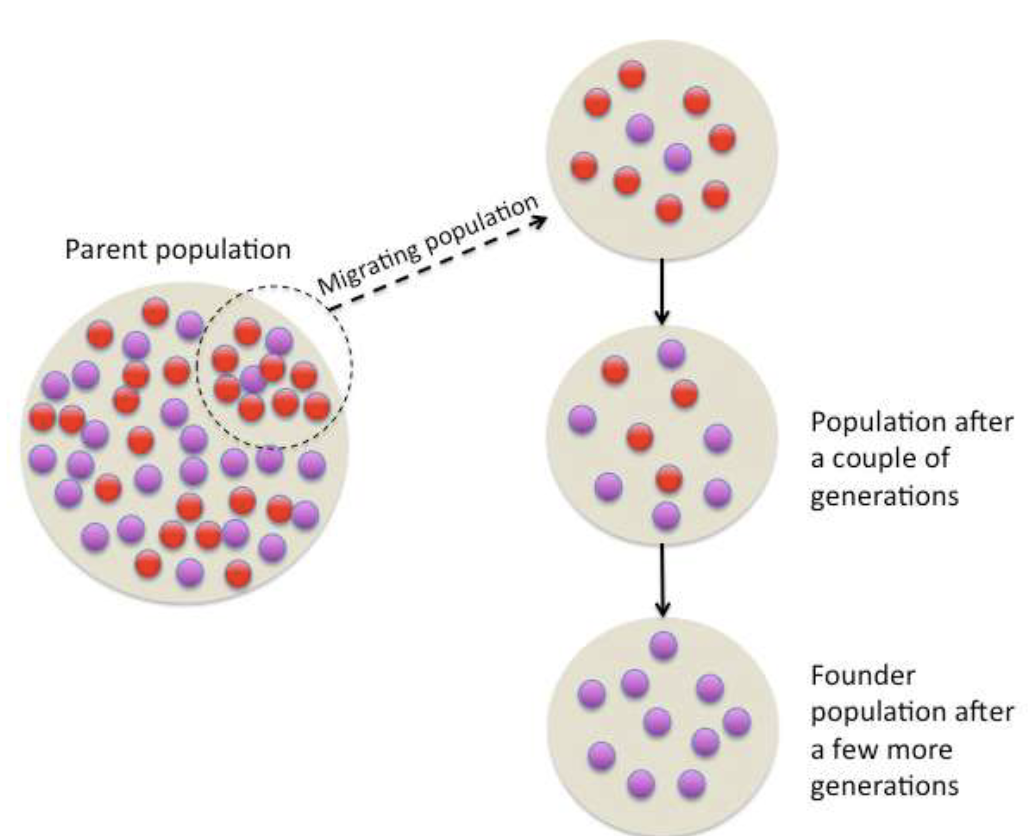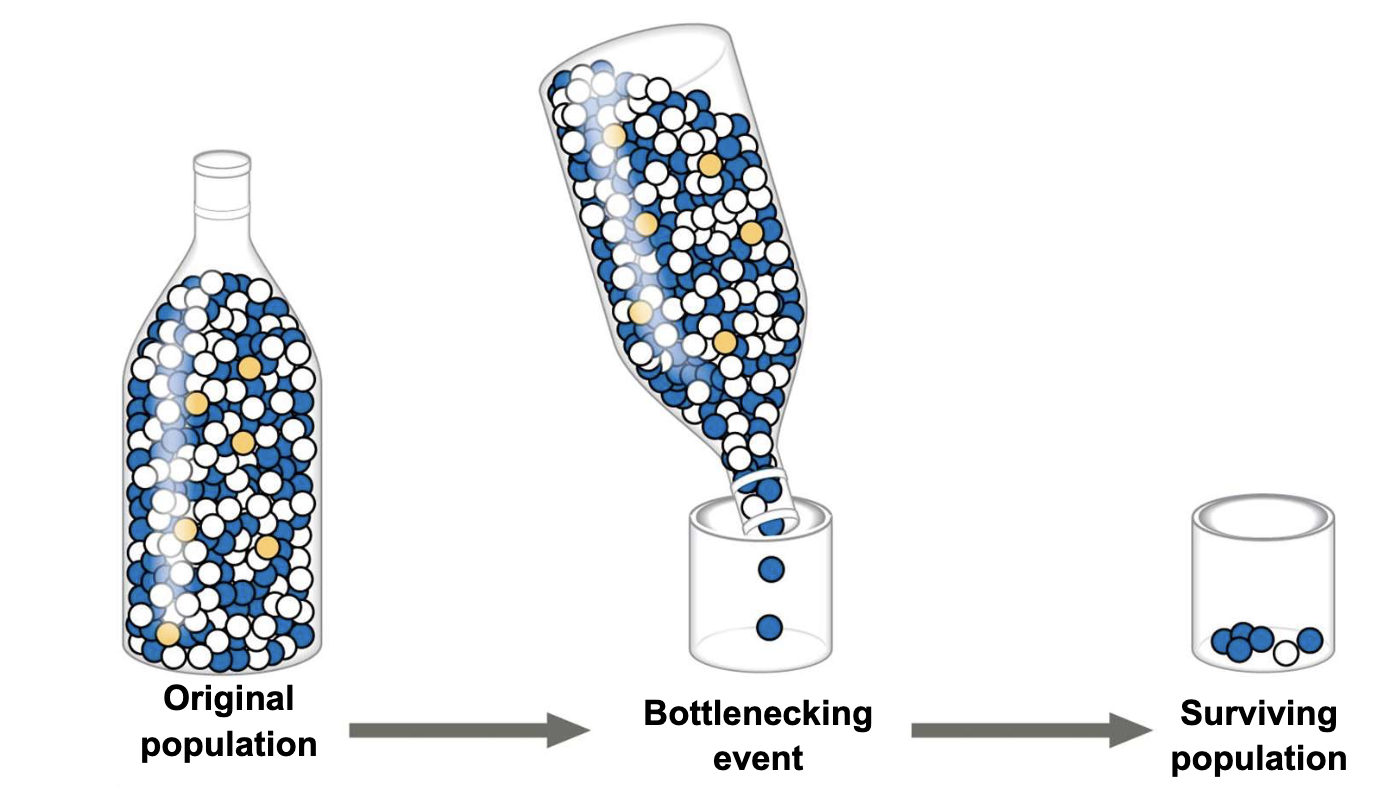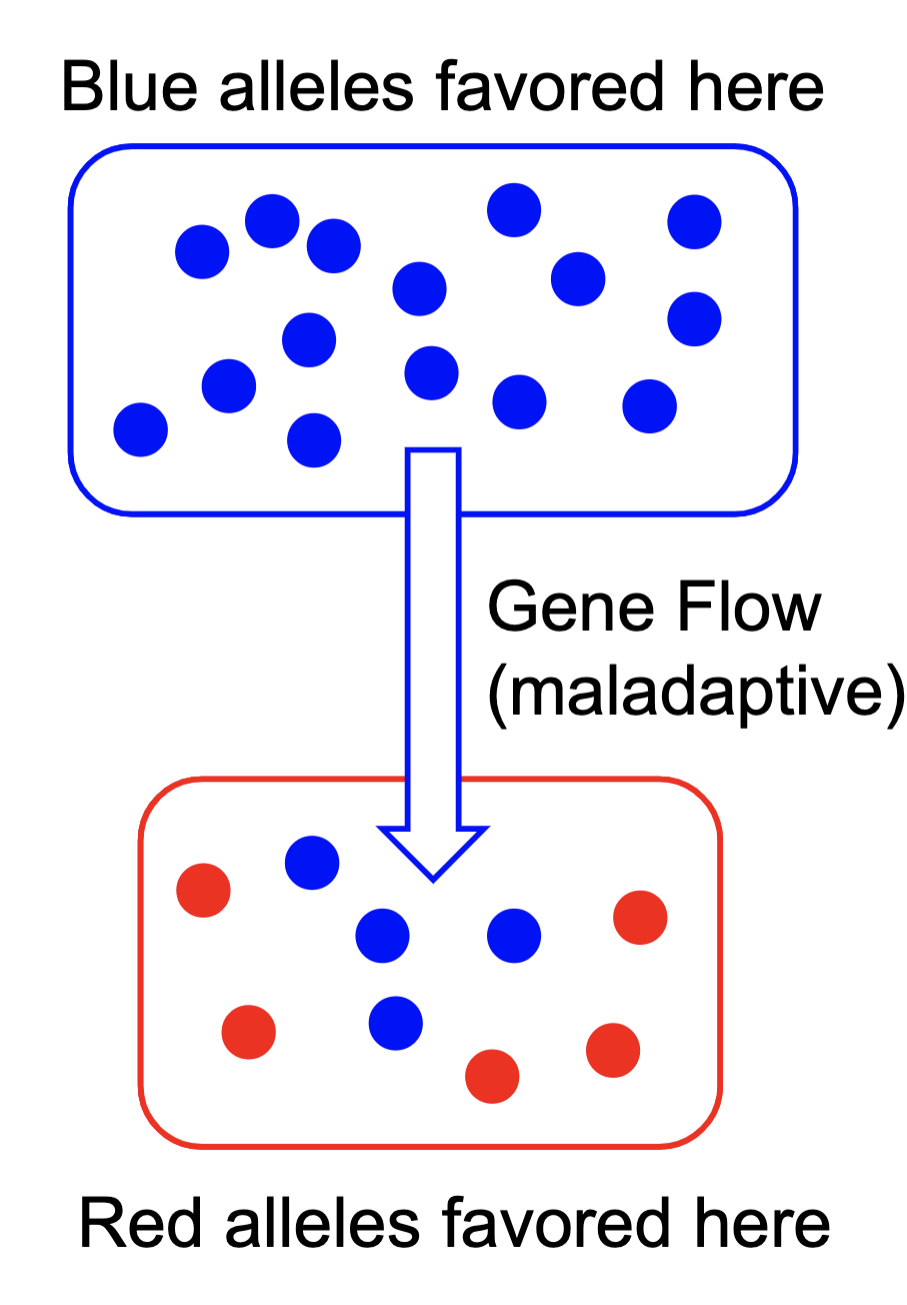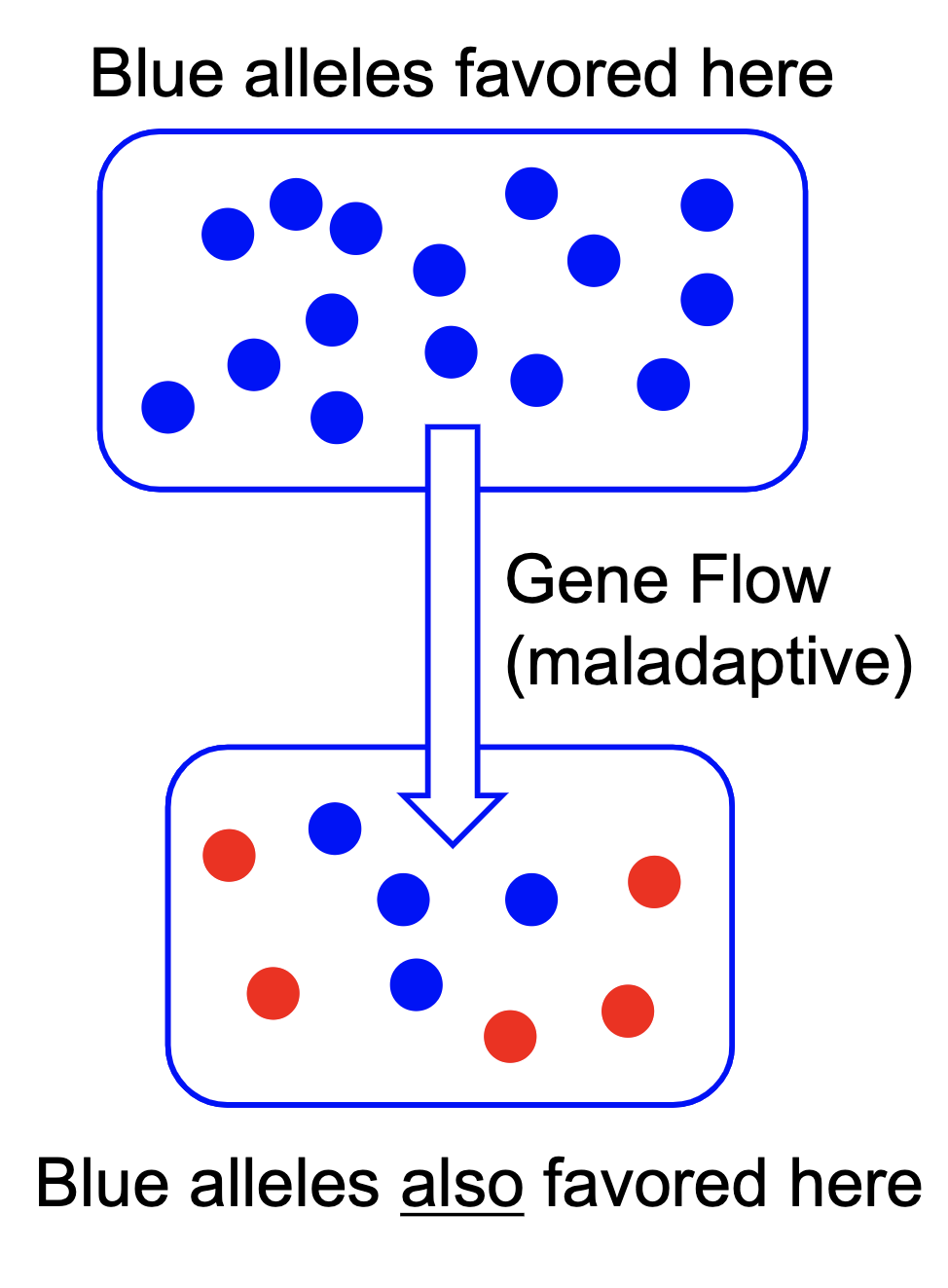Biology 5C Final
0.0(0)
Card Sorting
1/117
Earn XP
Description and Tags
Study Analytics
Name | Mastery | Learn | Test | Matching | Spaced |
|---|
No study sessions yet.
118 Terms
1
New cards
Evolution
A change in allele frequency in a population over time
2
New cards
Mechanisms for Evolution
Natural selection, genetic drift, gene flow
3
New cards
Genetic Drift
The random change of allele frequencies from one generation to the next due to random sampling
4
New cards
Population Size
The number of organisms in a population
5
New cards
How Genetic Drift Causes Evolution
Genetic drift makes evolution more random and reduces genetic variation
6
New cards
The Effects of Population Size on Genetic Drift
Drift causes more extreme changes in smaller populations
7
New cards
Founder Effect
The acceleration of genetic drift when a small number of individuals become isolated from a larger population

8
New cards
Bottleneck Effect
A magnification of the effect of genetic drift due to a reduction of size within population

9
New cards
Gene Flow
The movement of alleles between populations due to migration, tends to make populations more genetically similar over time
10
New cards
The Effects of Gene Flow on Allele Frequency Differences Between Populations
Genetic swamping, adaptive introgression
11
New cards
Genetic swamping
The reduction in a population’s ability to adapt due to gene flow from maladaptive populations

12
New cards
Adaptive Introgression
The movement of beneficial (adaptive) alleles between populations, which facilitates adaption

13
New cards
Natural Selection
The differential survival and reproduction of individuals or genotypes due to differences in phenotype
14
New cards
Selection for
A trait causes both it and underlying allele to increase frequency
15
New cards
Selection against
A trait causes both it and underlying allele to decrease frequency
16
New cards
Fitness
A quantitative measure of how much an individual with a particular phenotype or genotype will contribute to the next generation
17
New cards
How does Fitness relate to Natural Selection
Natural selection favors organisms that can survive and reproduce
18
New cards
3 General forms of Selection
Directional, disruptive, stabilizing
19
New cards
Directional Selection
Natural selection that causes trait distribution to shift in one direction (increase or decrease)
20
New cards
Disruptive Selection
Natural selection in which individuals on both extremes survive and reproduce more than individuals in the middle (selection for extremes, selection against intermediate)
21
New cards
Stabilizing Selection
Natural selection in which intermediate phenotypes survive and reproduce more than the extreme phenotypes (selection for intermediate, selection against extremes)
22
New cards
Sexual Selection
A process in which individuals with certain inherited characteristics are more likely to obtain mates than other of the same sex
23
New cards
Sexual Dimorphism
Differences in phenotype between sexes in animals
24
New cards
Balancing Selection
Natural selection that maintains more than one phenotypic form or allele, maintain variation rather than reduces it
25
New cards
Speciation
An evolutionary process in which one species split into two more more species
26
New cards
Microevolution
Evolutionary change below species level
27
New cards
Macroevolution
Evolutionary change above species level
28
New cards
Species
The basic unit of classification and taxonomic rank of organisms
29
New cards
Biological Species Concept
Definition of species in which a group of populations whose members have the potential to interbreed, produce offspring, and does not interbreed with other species
30
New cards
Reproductive Isolation
When biological barriers impede members of two different species from interbreeding and producing offspring
31
New cards
Prezygotic Barriers
Block fertilization from occurring by impeding different species from attempting to mate
32
New cards
Habitat Isolation
Two species that occupy different habitats within the same area rarely encounter each other
33
New cards
Temporal Isolation
species that breed at different times cannot mate
34
New cards
Behavioral Isolation
Courtship rituals and other behaviors unique to a species
35
New cards
Pollinator Isolation
Species of a plant attract different types of pollinators
36
New cards
Mechanical Isolation
Mating is attempted, but morphological differences prevent its successful completion
37
New cards
Gamete Isolation
Sperm of one species may not be able to fertilize eggs of another species
38
New cards
Zygote
The diploid cell produced by the union of haploid gametes during fertilization (fertilized egg)
39
New cards
Postzygotic Barriers
Prevent hybrid zygotes from developing into viable, fertile adults
40
New cards
Postzygotic Barriers occur by
Reduced hybrid viability, reduced hybrid fertility, hybrid breakdwon
41
New cards
Reduced hybrid viability
Genes of different parent species may interact in ways that impair the hybrid’s development or survival in its environment
42
New cards
Reduced hybrid fertility
If an organisms’s parents differ in chromosomes number or structure, meiosis can fail and lead to sterility in offspring
43
New cards
Hybrid Breakdown
First generation hybrids are viable and fertile, but second generation offspring are sterile or unhealthy
44
New cards
Reductive Isolation Occurs Along a Continuum
Species can be mostly distinct, but still exchange genes at low levels
45
New cards
Morphological Species Concept
Definition of a species in terms of measurable subjective criteria (structural features)
46
New cards
Ecological Species Concept
Definition of species in terms of ecological niche, the sum of its interactions with living and nonliving parts of the environment
47
New cards
Allopatric Speciation
Populations are genetically isolated
48
New cards
Sympatric Speciation
Populations are mixed, not genetically isolated
49
New cards
The Process of Allopatric Speciation
The gene pools of isolated populations may diverge genetically through mutation, natural selection, genetic drift
50
New cards
Separation can result from
Vicariance, dispersal
51
New cards
Vicariance
division of an existing population by a barrier
52
New cards
The Process of Sympatric Speciation
Speciation occurs in populations that live in the same geographic area and requires gene flow that is reduced by drivers
53
New cards
Drivers of Sympatric Speciation
Polyploidy, sexual selection, hybrid differentiation
54
New cards
Polyploidy
Mutations causes whole genome duplications and form a new species within a single generation without geographic separation
55
New cards
Autopolyploids
An individual that has more than two chromosomes derived from a single species
56
New cards
Allopolyploids
A fertile individual that has more than two chromosomes derived from different species interbreeding and combining their chromosomes
57
New cards
Habitat Differentiation
Adaptation to new habitats and resource sources
58
New cards
Hybrid Zone
A region where members of different species mate and produce hybrid offspring
59
New cards
Hybrid
Result of mating between species with incomplete reproductive barriers
60
New cards
Possible Outcomes in a Hybrid Zone
Reinforcement, fusion, stability, hybrid speciation
61
New cards
Reinforcement
If hybrids are less fit than the parent species, then natural selection strengthens prezygotic barriers to reproduction and reduces the changes of hybrid formation
62
New cards
Fusion
Gene flow between species can weaken reproductive barriers and the two parents species may fuse into single species
63
New cards
Stability
A hybrid zone in which hybrids continue to be produces, causing the hybrid zone to be stable
64
New cards
Hybrid Speciation
Hybrids in a hybrid zone may become reproductive isolated from both parent types
65
New cards
Punctuated Equilibrium
In the fossil record, long period of apparent stasis, in which a species undergoes little to no morphological change, interrupted by brief periods of sudden change
66
New cards
According to the fossil record, the rate of speciation varies
Evidence from lab studies and instantaneous polyploid speciation show that speciation can be rapid
67
New cards
Abiotic Synthesis
The synthesis of organic molecules by physical or chemical means
68
New cards
Macromolecule
Large molecules, often composed of smaller subunits
69
New cards
Protocells
Early, simple precursors of cellular organisms
70
New cards
Earliest fossils of single celled life on Earth dates to
3\.5 billion years ago
71
New cards
Simple reactions among C, O, N, H could have been fueled by
Lightning, hydrothermal vents, volcanic eruptions
72
New cards
Muller-Urey Experiment (1953)
Created conditions like early earth in lab, heated water, methane, ammonia, and hydrogen and applied electrical charge, observed the formation of 11 out of the 29 essential amino acids
73
New cards
The Reasons RNA is Thought to be a Likely Key Player in the Origin of Life
RNA can function like an enzyme (ribosomes) and information storage molecule
74
New cards
RNA World Hypothesis
Hypothesis that early earth relied on mostly RNA, with DNA evolving later
75
New cards
Fossils
Impressions of prehistoric organisms preserved in petrified form or a mold in rock
76
New cards
Radiometric Dating
A method using the decay of radioactiv3e isotopes in substances as a clock to date them
77
New cards
The General Sequence of Events in the History of Life
Prokaryotes, atmospheric oxygen, single celled eukaryotes, multicellular eukaryotes, animals, colonization of land, humans
78
New cards
Prokaryotes (1.5 billion years ago)
Single celled organisms that doesn’t have nucleus or specialized organelles
79
New cards
Stromatolies
Structures that are formed by single celled organisms or cyanobacteria
80
New cards
Eukaryotes (1.8 billion years ago)
Multicellular organisms with DNA, chromosomes, nucleus
81
New cards
Endosymbiosis
Symbiosis in which a symbiotic organism lives inside another
82
New cards
Cambrian Explosion
A period of accelerated evolution of marine organisms that occurred about 530 million years ago
83
New cards
Possible Causes of Cambrian Explosion
Increased oxygen, increased genetic complexity of organisms, climate change
84
New cards
Adaptive Radiation
The rapid origin of many new species due to the adaptation to new environments (fungi, plants, arthropods, vertebrates)
85
New cards
Continental Drift
The movement of tectonic plates on the surface of the Earth, reconfigured landmasses
86
New cards
Extinction
The disappearance of species due to unfavorable changes in habitat
87
New cards
Mass Extinction
A large scale extinction event involving many species
88
New cards
The Broad Evolutionary History of Ancient and Modern Humans
Humans evolved in Africa from primate ancestors, migrated and lived alongside archaic groups, genetic diversity result of genetic drift
89
New cards
Aboreal
Living in trees or forests
90
New cards
Relative Brain Size
The size of an animal’s brain relative to its body size
91
New cards
Hypothesis on why the relative brain size and complexity of apes greater than other primate species
Living in complex social groups, changes in diet, environmental variability
92
New cards
Why linear depictions of human evolution are wrong
Humans did not evolve from modern apes, we share a common ancestor (5.5 mya)
93
New cards
Hominins
The clade that includes modern humans, chimpanzees, and extinct ancestral human like species
94
New cards
Key differences of hominins from other primates
Smaller canines, bipedalism, loss of grasping feet, tool making and use, larger relative brain size
95
New cards
Bipedalism
The practice of walking upright and on two feet
96
New cards
Knapped/flaked edge
A jagged edge on a stone tool made by striking the edge with another rock or pressure
97
New cards
Archaic Humans
Groups of closely related humans or human like species that live along side modern humans
98
New cards
Neanderthals
Group of archaic humans mostly found in Europe
99
New cards
Denisovan
Group of archaic humans mostly found in central Asia
100
New cards
The History of Intermixing Archaic Humans and evidence supporting it
Using DNA sequencing, researchers fully sequenced gnome of Neanderthals and Denisovan individuals to compare to modern human genome